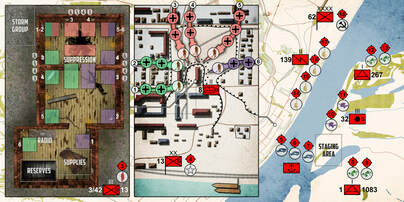 Full disclosure: DVG sent me a review copy of Pavlov's House. What is this game about? Pavlov's House is a game of survival under brutal circumstances during the Battle of Stalingrad. The real Pavlov's House was a strategically-located apartment building that Russian soldiers—including the eponymous Pavlov—held for nearly two months against a relentless Nazi onslaught. In the game, you win by surviving all the way to the end of the German assault deck. But you can lose in a number of ways. You can be straight-up destroyed by German tanks, Nazi soldiers can reach Pavlov's House, you can lose all of your support from the army outside, or you can fail to feed your men and thus cause the death by starvation of all who live inside the apartment building. And even if you win, there is a pretty brutal victory point calculation to help you decide how well you won. Typically, you won't get a big win... if you win at all. Mechanically, Pavlov's House is very interesting. The game comes with a tripartite board, representing different levels of the conflict as the battle progresses. As the player, you'll control both the left and right sides of the board—Pavlov's House itself, and the Soviet 62nd Army outside that is trying to support it. The area in the middle of the board represents Nazi encroachment, and it's where you add enemy soldiers and tanks. As the Soviet 62nd Army, you'll be drawing cards and choosing how best to support Pavlov's House. You can work on gathering supplies, recruiting more soldiers, installing anti-aircraft guns, and more. Within Pavlov's House, you'll be using limited movements and activations to arrange soldiers inside the house and fight back the approaching Germans. When you get better at the basic game (haha good luck), you can add in tactics cards to make the Nazis more brutal, as well as operational support cards to give yourself extra challenges as the Russian army.  The three-part game board, from the PnP files on BGG. The three-part game board, from the PnP files on BGG. How does it play solo? Technically, you could play Pavlov's House with one, two, or three players. But it's definitely strongest with one—the AI is sufficiently brutal but also sufficiently low-upkeep, while controlling both Russian sides of the board gives you the correct amount of "things to do" for a satisfying gameplay experience. Overall Thoughts Pavlov's House is excellent. There are so many tense decisions to make, and you'll always be left wondering if you've made the right ones. What forms of outside support will you prioritize? Will you focus on getting food into Pavlov's House? Will you bulk up your communication channels to try to get extra actions on the next turn? Will you put all of your energy into anti-aircraft tokens? (I highly recommend heavy investment in anti-aircraft tokens.) And within Pavlov's House itself, you have to decide how you'll use limited movements and activations. Which enemies will you try to take out? What weapons will you use? Will you bring in additional soldiers, even without the guarantee that you can feed them all? Meanwhile, the Nazi approach is relentless. Stukas will blow up all of your outside support spaces (especially the ones you had especially big plans for), while tanks, riflemen, and scouts will creep up on all sides of your building and work to lower its defenses. When I play this game, I really do feel like I'm trapped in an apartment building and fighting for my life. While Pavlov's House is a thrilling and intense gaming experience, you should be aware that you may not enjoy it much if you hate having your fate decided by die rolls. You will roll dice constantly, both to represent Nazi attacks on your own forces and to determine whether your attempts to suppress German encroachment have been successful. Get ready to plan a strong defense and spend all of your anti-aircraft tokens, only to roll low and get bombed anyway. For me this generally just adds to the drama of the proceedings, but if that doesn't sound like your thing, think twice about this one. You'll also get the occasional draggy turn where you draw no interesting cards for the 62nd Army and/or have to spend your turn in Pavlov's House refreshing everyone rather than making progress. But for me, Pavlov's House is a current favorite that I expect will still be hitting my table a year from now and beyond. The gameplay is simple but tense, and it's riveting to watch the story of each game unfold. I backed the next game in this series, Castle Itter, on the strength of Pavlov's House, and I am excited about that one, too. Do I recommend it? Unless you are allergic to dice, I absolutely recommend Pavlov's House. It's brutal, historical, and engrossing. I am so glad I have a copy of this game. Overall Rating: 4.5 stars Rating scale: 5 stars — I love it! 4 stars — I really like it. 3 stars — I like it. 2 stars — It's okay. 1 star — Meh.
3 Comments
James Crimmins
2/15/2019 03:25:15 am
Nice Review! This one caught my eye (I'm a DVG fan) when it was on KS but I've been in a buying freeze for a bit. Would you say this is kinda a tower defense game or is that not apropos? How long does a game take including setup/breakdown?
Reply
2/15/2019 04:52:33 am
Thanks for reading, James! Pavlov's House definitely has some elements of tower defense, with the outside support aspect of the 62nd Army adding extra flavor. It really does take about an hour to play, and setup is quick. I always make sure the cards are ready to shuffle and go when I put the game away, which makes getting started a lot easier!
Reply
Herb Boutilier
9/10/2020 10:33:54 am
Great review. I've been playing a solo game called Crowbar by Flying Pig games, but it takes me three hours or so to play. I am attracted to the one hour play time of this game and have bought it based on your review! thanks.
Reply
Your comment will be posted after it is approved.
Leave a Reply. |
AuthorMy name is Liz Davidson, and I play solo board games. A lot of solo board games... Archives
August 2021
Categories
All
|
 RSS Feed
RSS Feed